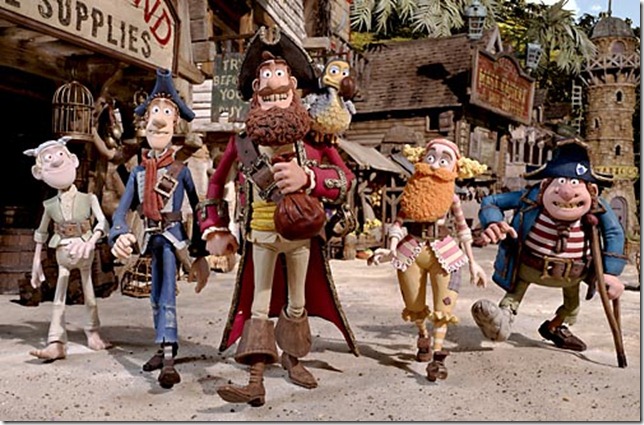Grown men don’t usually play with clay, but Peter Lord has made quite a tidy career doing exactly that.
A co-founder of Aardman Animations, the Bristol, England studio that gave the world the Wallace & Gromit series, Lord co-directed and co-wrote the 2000 feature Chicken Run and directs The Pirates! Band of Misfits, in theaters today — all in playful stop-action.
Fascinated by animation since high school, Lord began by dabbling in the conventional hand-drawn format, “but that was hard work,” he recalls. “This seemed easier, it really did. It seemed more spontaneous.” As he talks, Lord cradles in his arm a 1/6-scale replica of the Pirate Captain, the movie’s lead character (voiced by Hugh Grant). The plot concerns this benign corsair’s attempt to win the coveted Pirate of the Year Award.
Although the stop-action process has been improved over the years with the application of computers, it remains a very hands-on, manual art. To an observer, it looks to be painstaking and tedious. “Yeah, people always think it is. I don’t think it is,” scoffs Lord. “Painstaking, yes, but not tedious, no. This thing with puppets, it just suited me.”
Aardman was established in 1972, exactly 40 years ago. “The story was we had a character and we called him Aardman, a combination superhero and aardvark,” laughs Lord, 59. “Anyway, we sold our first film to the BBC for like 20 pounds. They said, ‘Who do we make the check out to?’ and that’s when we came up with the stupid name.”
Each Aardman film has moved stop-action production techniques forward a bit. But at its most basic level, “You’ve got an articulated puppet that you can control very exactly, and you move it and take a photo, move it and take a photo.” But, Lord quickly adds, “The guys who make the puppets are now so experienced that they make way better puppets.”
The Pirates is the first Aardman project that makes use of 3D printing. “Do you know about 3D printing?,” Lord asks patiently. “It sounds like science fiction, but that (character’s) mouthpiece is animated on a computer and then the computer files are put into a 3D printer and they print out in solid resin. Like magic. So that was jolly new to us.”
The other major advance since Chicken Run 12 years ago is the increased use of computer-generated imaging (CGI). “On ‘Chicken Run,’ we had like three CG shots and on this we had, you know, 400 or whatever it was,” he says. “A tiny thing like candles in the chandelier had CG flames.”
 Even action sequences that seem improbable in stop-action can be achieved that way thanks to Aardman’s ability to digitally erase the supports which allow objects to be constantly repositioned, like the huge barrels that bounce and roll across the pirate ship’s deck late in the movie.
Even action sequences that seem improbable in stop-action can be achieved that way thanks to Aardman’s ability to digitally erase the supports which allow objects to be constantly repositioned, like the huge barrels that bounce and roll across the pirate ship’s deck late in the movie.
“What you’re not seeing is the metal rigs. In the ‘Chicken Run’ days, we tried it with string, which was a nightmare,” Lord concedes. “Now we use rigid metal rigs, which you just paint out afterwards. That too is liberating.
“In the old days, a lot of energy went into not making a mistake. Now we just go for it, go for what we want and if you mess up, you know it can probably be used.”
As with the Oscar-laden Pixar studios, the technical aspects take a back seat to the crafting of the story and the jokes. “You tell the story and use jokes that you believe in, that make you laugh,” says Lord. “Whether it makes you laugh as a sophisticated adult or as a child, I do genuinely believe — it sounds corny — that we all have that child inside us.
“I think if you approach it with enough cheerful gusto and good humor, people will be swept along. And if something passes you by, that’s OK.”
In developing the story, Lord and the creative team studied classic pirate movies. Up to a point.
“We had, of course, a shelf of pirate movies on DVD for reference, and I skimmed through them, but didn’t linger very long. Because I never saw what I was looking for — an idealized vision of what the pirate movie ought to be like,” says Lord. “The one that made the most impression on me was (1952’s) ‘The Crimson Pirate,’ with Burt Lancaster.”
Lord says that the film’s anything-for-a-laugh tone is strongly influenced by Monty Python. Still Aardman caught flack for a joke about lepers.
“Yes, true, yes we did. We had a leprosy gag in the trailer, a schoolboy joke, where the (leper’s) arm falls off. He now says, ‘This is a plague boat. I’d give my right arm for some gold,’ whereupon his left arm falls off and he goes, ‘Oops.’ ”
As to the former leper joke, Lord notes, “Everybody laughed at it, but I understand there will be a very small minority of people who would be offended by it. And of course humor often offends people, doesn’t it? It’s meant to, in a way.”
Still, The Pirates! Band of Misfits is built of upbeat and positive humor. “I think it’s joyous. We made it that way,” says Lord. “We made it with passion and good-heartedness. There is a point to it, a message that friends and family are more important than wealth and fame. That isn’t rocket science, but it makes me feel good.”
